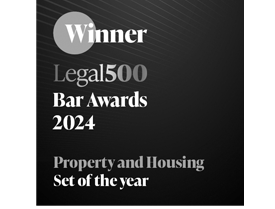Purbeck House: remediation order made against Leaseholder on Application by Freeholder 19 June 2025
In our latest article about the Building Safety Act 2022, Joe Ollech and Tricia Hemans consider the recent decision of the FTT in Barclays Nominees (George Yard) Limited v LDC (Oxford Road Bournemouth) Limited HAV/00HN/BSA/2024/0001 and 0002 (“Purbeck House”).
The decision of the FTT to make a remediation order in the Purbeck House case is another – and unsurprising example - of the Tribunal taking a pragmatic approach to building safety and the purpose of the BSA. For those who are not aware of the essential background, this application concerned two blocks of student accommodation in Bournemouth that houses approximately 500 students.
Although a fairly lengthy decision, much of it is a recitation of the course of the evidence, cross examination and submissions. Relatively few broad points of principle can be drawn from it, however, the approach taken by the FTT in light of the nature of the parties before it and as to when its discretion should be exercised is notable.
Nature of the Parties
It is of some interest that the applicant “interested party” in this case was the freeholder, and the respondent “relevant landlord” was the leaseholder of both buildings. The vast majority of the remediation orders which have been made thus far have been the result of applications made by leaseholders against their landlords – albeit with a few notable exceptions: e.g. the 5 Praed Street case where the application was made by Westminster City Council, and the Vista Tower, Chocolate Box and Focus Apartment cases, where the applications were made by the Secretary of State.
In Purbeck House, the parties had been engaged in discussions regarding remediation works to the buildings – in particular with regard to fire doors (of which there some 1,200) and cladding, which was a mixture of terracotta and Kingspan steel panels. At the time the hearing took place the respondent had approximately six years left on its lease.
One can immediately sense the commercial factors at play beneath the surface of this litigation. The respondent faces a large and expensive programme of repair and remediation on a short-term asset. The freeholder faces receiving a building back in a few years’ time that is non-compliant and unsafe.
On behalf of the Leaseholder, it was said that the Freeholder, in seeking the remediation order, was doing so for its commercial benefit and not to provide leaseholder protection. However, the FTT accepted that requiring the remediation of defects is a legitimate aim for the applicant to pursue. This was even in the face of their finding that maintaining the value of the asset was also a core principle of the Freeholder company. Whilst recognising that cost and asset value clearly form part of a business’ decisions, this was not the approach taken under the BSA. The FTT noted that the making of a remediation order is not a punitive measure, the focus of the Act is to ensure building safety. It was still appropriate to make an order. Not much was said about whether and to what extent the exercise of the discretion would be impacted in a case where an applicant freeholder was motivated solely or primarily by commercial rather than safety factors and one wonders whether the outcome would differ in such a case, notwithstanding the existence of relevant defects.
Exercise of the Discretion
In relation to the exercise of the discretion, the points raised were whether the making of an order should be automatic where defects existed, unless exceptional circumstances were shown (the applicant freeholder’s position) or whether the discretion was at large (the respondent leaseholder’s position). It was also argued by the respondent that remediation orders were not appropriate for matters of wear and tear, where the position was, for example, that compliant fire doors had been properly installed originally but time and movement had given rise to gaps and damage. There was also an issue arising with regard to the need for consent by the applicant itself under the leases which had not been agreed, although that was in part because the remediation works required were not agreed.
The FTT did impose a remediation order, but it is difficult to draw precise answers to these particular questions from the decision, save the that FTT confirmed the obvious point that it has a discretion in any given case.
On the first point, the FTT’s reasoning did not suggest that once a relevant defect was established the order would be automatic unless exceptional circumstances justified not making the order. The overall tenor of the decision shows that the Tribunal was concerned in general both by having seen evident defects in the building on its inspection, and the approach taken to both evidence of fact and the expert evidence by the respondent.
The Tribunal was unimpressed that it had offered only relatively junior employees to give evidence, who could not speak authoritatively as to the decision-making processes at what is a large institutional landlord. Whilst neither side’s expert was found to be particularly helpful either way, the Tribunal was unhappy that the respondent’s expert - who had a long term association with the company - was at times advocating its position, failed to take a “compliance based” approach to risk but instead considered the cost relative to risk, and had not critically assessed the use of Kingspan cladding in a residential context as opposed to commercial or storage use.
The Tribunal also expressed its concern – at least twice - to have heard that in terms of the fire safety evacuation drills the respondent was aware that a number of students would not leave the building, but that it did not record how many had remained but was confident “it wasn’t in the 100s”. It was also noted that the respondent had known about the defects for 5 years but had not remedied them. Like in the Chocolate Box case, it did not make a difference that the respondent had, by the time of the hearing, begun a programme of works. One suspects that the overall approach by the respondent made an important impression on the Tribunal with regard to fire safety overall, and the critical importance of making sure that hundreds of people are kept safe.
In relation to the arguments regarding wear and tear, the FTT accepted the respondent’s arguments. While it accepted that there were defective doors and that those doors amounted to a building safety risk, the FTT were not satisfied that they had been constructed in a defective manner. Having regard to section 120(3), defective though they were, the doors could not be relevant defects for the purposes of the Act.
Finally, as regards the potential need for the respondent leaseholder to obtain the applicant freeholder’s consent to carry out any works required by the remediation order, the FTT did not consider this to be a stumbling block. Instead, the Tribunal treated that rather lightly assuming that such consents would be forthcoming – “Whilst issues were raised as to the form of licence and whose solicitor should provide the form to be used these are in our judgment usual commercial matters that parties should be able to agree. Plainly the Applicant wants works undertaken. We believe such negotiations can take place in tandem with any application to the Building Safety Regulator. In our judgement if agreement cannot be reached this may be grounds to seek a variation of the order”.
This approach is borne out by the terms of the remediation order which is appended to the decision in which the parties have liberty to apply, including as to the schedule of works. The interplay between the Act and landlord and tenant covenants is an area still unfolding. We will all need to wait and see whether such applications to vary are to be treated generously in the face of a freeholder withholding consent under the terms of the lease on the one hand but seeking to enforce the terms of a remediation order on the other.
Concluding Thoughts
The decision overall is unsurprising. The Tribunal saw for itself a building with obvious defects, which the relevant landlord had known about for some five years prior to the hearing, and who had delayed or had not carried out a programme of works primarily for commercial considerations, whilst displaying a certain lack of care in its fire safety drill routines. Whilst the last consideration is not itself a building defect, obviously, it is apparent from the way the Tribunal returned to this aspect that it formed part of the impression it drew from the evidence.
On the flip side of the coin, whilst recognising that the applicant no doubt had its own commercial interest in mind “we were satisfied that the need for remediation of a defective building was also important to the Applicant. This is what one would expect from a large corporate entity following on from the dreadful events of the Grenfell Tower tragedy.”
One is left wondering as to whether a different outcome might result in different circumstances – if, for example, a leaseholder landlord has a very short term left when defects are identified, and the commercial burden of carrying out the works are very high relative to that interest, and that in the meantime it puts in a place a rigorous and effective substitute regime such as a waking watch and rigorous evacuation procedures.
Download: Purbeck House: remediation order made against Leaseholder on Application by Freeholder
Back to articles







